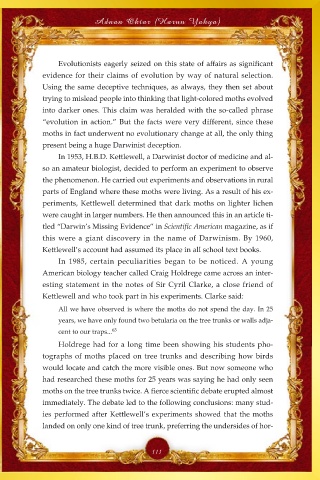Page 113 - Death of the Darwinist Dajjal System
P. 113
Adnan Oktar (Harun Yahya)
Evolutionists eagerly seized on this state of affairs as significant
evidence for their claims of evolution by way of natural selection.
Using the same deceptive techniques, as always, they then set about
trying to mislead people into thinking that light-colored moths evolved
into darker ones. This claim was heralded with the so-called phrase
“evolution in action.” But the facts were very different, since these
moths in fact underwent no evolutionary change at all, the only thing
present being a huge Darwinist deception.
In 1953, H.B.D. Kettlewell, a Darwinist doctor of medicine and al-
so an amateur biologist, decided to perform an experiment to observe
the phenomenon. He carried out experiments and observations in rural
parts of England where these moths were living. As a result of his ex-
periments, Kettlewell determined that dark moths on lighter lichen
were caught in larger numbers. He then announced this in an article ti-
tled “Darwin’s Missing Evidence” in Scientific American magazine, as if
this were a giant discovery in the name of Darwinism. By 1960,
Kettlewell’s account had assumed its place in all school text books.
In 1985, certain peculiarities began to be noticed. A young
American biology teacher called Craig Holdrege came across an inter-
esting statement in the notes of Sir Cyril Clarke, a close friend of
Kettlewell and who took part in his experiments. Clarke said:
All we have observed is where the moths do not spend the day. In 25
years, we have only found two betularia on the tree trunks or walls adja-
cent to our traps... 63
Holdrege had for a long time been showing his students pho-
tographs of moths placed on tree trunks and describing how birds
would locate and catch the more visible ones. But now someone who
had researched these moths for 25 years was saying he had only seen
moths on the tree trunks twice. A fierce scientific debate erupted almost
immediately. The debate led to the following conclusions: many stud-
ies performed after Kettlewell’s experiments showed that the moths
landed on only one kind of tree trunk, preferring the undersides of hor-
111

